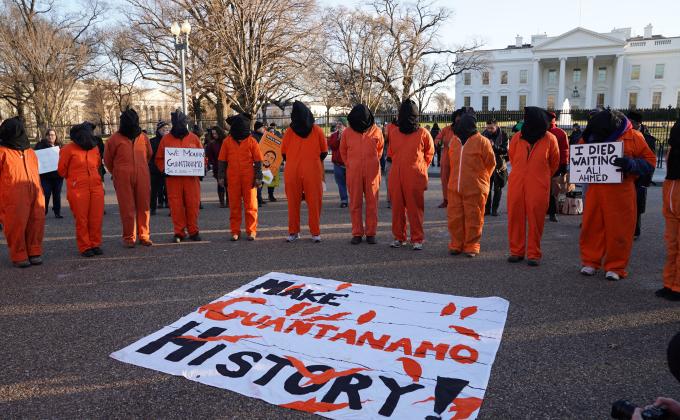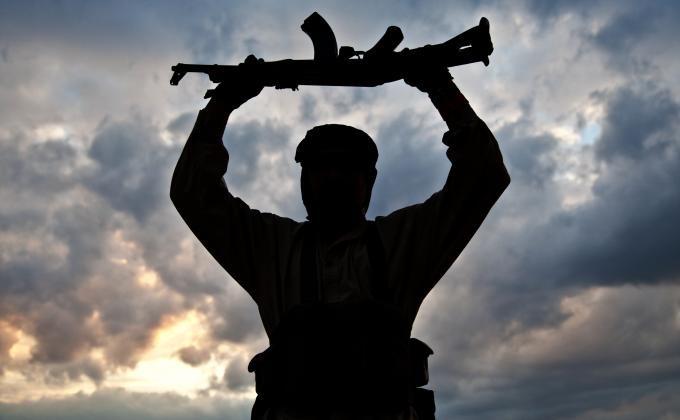The storming of the Capitol Building that happened on 6 January in Washington, DC shocked the world, but was neither unexpected, nor unprecedented. Several experts had predicted the elections could spark protests that extremists, in particular right-wing (including anti-government) extremists, would exploit to commit violence. Few anticipated it would escalate this far that an angry mob would forcefully enter the Capitol building and disrupt the confirmation of the election results. Examining both conceptual and legal definitions of some of the primary descriptions of the attack on the Capitol, we discuss whether it can be considered as an act of domestic terrorism or as another political crime (including a coup attempt, treason, seditious conspiracy, rebellion or a riot). Finally, we discuss the implications of the attack, as well as key steps that should be taken moving forward to prevent further violence. We believe it is important to examine these definitions for several reasons including holding those accountable for the actual crimes they have committed, as well as the public perceptions of how justice is administered in the follow up of the attack on the Capitol. Additionally, the utilisation of specific terms speaks to how the current situation, as well as its perceived threat level, is understood and responded to by the government. Our analysis is not focused on those who peacefully (and legally) gathered, but on those who conducted violence in particular at events at the Capitol.
Was it domestic terrorism?
President-elect Joe Biden has already condemned the mob that stormed the Capitol as domestic terrorists. He said “they weren't protesters. Don't dare call them protesters. They were a riotous mob, insurrectionists, domestic terrorists. It's that basic. It's that simple.” But how does this hold up against conceptual and legal definitions of domestic terrorism? There is a long-standing recognition that there is no single definition of terrorism itself, and this has been disputed in both policy and academic circles (see for example Schmid, Jongman, and Stohl 1988; Weinburg, Pedahzur, and Hirsch-Hoeffler (2004); Schmid 2010; Jackson 2011, Ramsay 2014, or Schenin 2020). Schmid has even identified 250 unique definitions of terrorism. There are, however, some general aspects which the field largely agrees on. One survey by Schmid (2004) provides a definition based on the common denominators of seventy-three academic journals as: “Terrorism is a [1] politically motivated [2] tactic involving the [3] threat or use of force or [4] violence in which the pursuit of [5] publicity plays a significant role.” The role of intent amongst these diverse academic definitions differs. At an international level, States have also not agreed on a definition. United Nations Security Council Resolution 1566 (2004) comes closest to describing terrorism as: criminal acts, including against civilians, committed with the intent to cause death or serious bodily injury, or taking of hostages, with the purpose to provoke a state of terror in the general public or in a group of persons or particular persons, intimidate a population or compel a government or an international organisation to do or to abstain from doing any act. At a national level, according to section 18 U.S. Code § 2331 domestic terrorism means activities that involve acts dangerous to human life that are a violation of the criminal laws of the US or of any other nation State. The activities must appear to intimidate or coerce a civilian population, to influence the policy of a government by intimidation or coercion or to affect the conduct of a government by mass destruction, assassination, or kidnapping. Finally, the activities need to occur primarily within the territorial jurisdiction of the US. The FBI investigates terrorism-related crimes as they are outlined in this Federal Code. Among the mob that stormed the Capitol were members of domestic right-wing movements such as QAnon, The Proud Boys, the Boogaloo Bois and Three Precenters movement - yet these groups were not banned from attending the rally, which culminated in marching into the Capitol. Only Henry “Enrique” Tarrio, the leader of the Proud Boys, was banned from entering the District of Columbia to prevent him from joining the events of 6 January after he was arrested and released on another charge on 4 January. Some of the mob did appear to have planned the attack well in advance, including direct calls for violence, discussions around logistics, and even efforts to transport weapons. The attack was not a spontaneous act, but a culmination of planned violence that had been premeditated by some (not all) attendees for weeks. The Anti Defamation League has been tracking social media for months and seen a steady increase in violent rhetoric clearly supporting the notion that the Capitol was knowingly and willfully stormed. The attack on the Capitol was also not committed by members of a singular group. As Cynthia Miller-Idriss highlighted, persons at the rally represented “a toxic mix across the far right spectrum.” Not all persons necessarily shared the same intent to storm the Capitol. While they were motivated by a shared frustration with the election outcome, some had diverse aims to disrupt the political process, overturn the election outcome, and in some cases appeared to plan to take more serious, violent action. Based on the definitions above, in order to determine whether the storming of the Capitol can be considered an act of terrorism it is important to prove that an individual involved committed (or threatened to commit) a violent act(s) and were politically motivated to do so. In order to determine whether this requirement is met, looking into the statements of persons within the Capitol, or those including their social media postings prior to attending the Capitol, would help to determine whether such an intent was there. The use of different symbols such as flags and t-shirts, or props such as noose and gallows, and statements made specifically on recordings made during the attack, help to identify which extremist groups were represented, and could clarify the political intent of individuals. While it is important not to speculate on ongoing investigations, two men were arrested carrying zip ties at the Capitol building which could be seen as evidence that they intended to take hostages. Pipe bombs were found at both the Republican and Democratic National Committees, and molotov cocktails allegedly found in a man’s possession. A Reuters reporter at the Capitol tweeted: ‘I heard at least 3 different rioters at the Capitol say that they hoped to find Vice President Mike Pence and execute him by hanging him from a Capitol Hill tree as a traitor [for not overriding the certification of the election in favour of Biden]. It was a common line being repeated. Many more were just talking about how the VP should be executed.’ These are a few examples that illustrate that these individuals intended to cause harm and disrupt the confirmation of the election results. These cases would appear to meet the conceptual definition of terrorism above, and the threshold under the Federal Code of intent to influence the policy of a government by intimidation or coercion. This would be in line with other recent activities by far-right extremists, where in 2020 thirteen people, including several with alleged ties to far-right groups, were charged in federal and state courts for plotting to kidnap Michigan Democratic Gov. Gretchen Whitmer. Members of this group had apparently also discussed plots to storm the Capitol. There is also precedent for seemingly ‘spontaneous’ events to have in fact been pre-meditated attacks. For example, the attack on the US mission Benghazi, Libya in 2012 that killed four Americans, including the US ambassador were also initially thought to have started spontaneously, but turned out to be pre-planned. Ahmed Abu Khattala, a leader of a branch of Ansar al-Sharia in Libya, was found guilty on four charges: conspiracy to provide material support to terrorists, providing material support to terrorists, maliciously destroying and injuring dwellings and property and firearms offences and sentenced to twenty-two years in prison. Yet, although the storming of the Capitol Building may amount to an act of terrorism depending on the intent of the individual participant, there is no federally chargeable offense of domestic terrorism, despite the existence of a statutory definition. As a result, domestic terrorists often are charged for hate crimes or weapons-related crimes. Moreover, there are no designated domestic terrorist groups, and no equivalent for domestic terrorism to prosecution on the basis of material support for foreign designated terrorist organisations. Despite the fact that Department of Homeland Security 2020 Threat Assessment indicating that ‘Among domestic violent extremist (DVEs), racially and ethnically motivated violent extremists—specifically white supremacist extremists (WSEs)—will remain the most persistent and lethal threat in the Homeland’, the US has not taken significant steps to address domestic right-wing extremist groups. The State Department has only designated one foreign right-wing extremist group, the Russian Imperial Movement (and three of its leaders) as a Specially Designated Global Terrorist (SDGT) in April 2020. The priority for the US has predominantly been international terrorism, with a strong focus on jihadist terrorism (a point which has received criticism for its racialised and ethnic profiling). Thus, while terrorism charges themselves would not be possible in this case, there is symbolic significance for declaring these acts as domestic terrorism.
Was it an attempted coup?
Some have referred to the storming of the Capitol as an attempted coup, but according to experts a coup is an illegal attempt to overthrow the sitting government usually by the military or other government security forces. Advocating to overthrow the government is criminalised in section 18 U.S Code § 2385. However, it is unlikely that the current events qualify as a coup because those who have been identified with links to the military would have participated in an individual capacity, versus as part of an organised military or government force.
Was it treason?
Treason is the only crime defined within the Constitution. It is defined in section 18 U.S Code § 2381 and criminalises anyone who owes allegiance to the US if they levy war or adhere to the enemies of the US by giving them aid. Yet, in advance of the act, there must be clear action and intent to commit treason before this charge may be laid, and requirements for testimony are extremely strict. Furthermore, charges for treason are exceptionally rare and are highly unlikely in this case.
Was it seditious conspiracy?
The aim of seditious conspiracy is “to overthrow, put down or to destroy by force” the government of the US. It also includes “preventing, hindering or delaying the execution of any law” of the US or seizing, taking or possessing any property of the US and is criminalised under section 18 U.S Code § 2384. The main purpose of the mob was to ‘stop the steal’ and prevent the confirmation of the electoral college vote with violence. Considering the extensive amount of footage available showing the mob entering the Capitol and seizing and destroying government property, some of these actions could constitute seditious conspiracy, particularly to those who stormed the Capitol. Several Democrats, including Bernie Sanders and Elisabeth Warren, have labelled the acts as seditious.
Was it a rebellion?
Alternatively the storming of the Capitol could be labelled as an act of rebellion under section 18 U.S. Code § 2383. Rebellion is in fact incitement to violence against the government but has in practice rarely been charged in the US. The big difference between seditious conspiracy and rebellion is that rebellion involves violence against the government, whereas seditious conspiracy refers to structured incitement to rebellion. Seditious conspiracy is also more serious and is punishable by up to twenty years of imprisonment, whereas rebellion is punishable by a maximum of ten years of imprisonment. Democrats, but also some Republicans such as Adam Kinzinger and Mitt Romney have labelled the events as insurrection. Romney stated, “What happened here today was an insurrection incited by the President of the United States.”
Was it a riot?
The right to freedom of speech and peaceful assembly is protected under the First Amendment, and many attendees of the rally were within these rights. However, laws against rioting can be found at state and federal level. Code of the District of Columbia Chapter 13 § 22–1322 states that a riot is “a public disturbance involving an assemblage of 5 or more persons which by tumultuous and violent conduct or the threat thereof creates grave danger of damage or injury to property or persons.” Though the protest was initially lawfully planned (and approved), it is evident that the definition of riot can be applied to activities that evolved throughout the day. A significant proportion of persons that took part in the assault of the Capitol were from outside the Washington District and could - instead of being charged for rioting under the District of Columbia - be charged for rioting under section 18 U.S. Code § 2101. This distinguishes any person that travels between states who could be charged for either inciting a riot, organising and participating in a riot, committing violence in furtherance of a riot. In addition, persons can also be charged for civil disorder under section 18 U.S. Code § 231.
What charges have thus far been laid in the case of the Capitol?
On 7 January, the Washington DC Metropolitan Police Department had already arrested 70 individuals for unrest-related activities linked to the attack of the Capitol. The FBI are also still seeking information on several persons in relation to violence at the Capitol. While a significant number of these charges were for curfew violations, other charges included firearms charges and assaulting a police officer. In addition, the FBI will jointly, with the Washington police, investigate the death of police officer Brian Sicknick. Diverse, Federal charges have also been laid against eighteen persons (including two women) for violating a variety of laws such as section 40 U.S. Code § 5104(e)(1)(A)(i), which makes it a crime to, among other things, carry or have readily accessible a firearm or other dangerous weapon on Capitol Grounds. Other charges thus far have included those related to possession of an unregistered firearm; violent entry and unlawfully entering/remaining in buildings without lawful authorisation; theft of government property; assaulting a Federal law enforcement officer; and disorderly conduct on Capitol Grounds. Thus far, no charges related to terrorism, attempted coup, treason, seditious conspiracy, or rebellion or rioting as outlined above have been laid. Though very distinct in its context (which focused on police brutality), comparatively during the Black Lives Matters (BLM) protests, up to fives times the number of arrests were made in DC against protestors in a single day (June 1) (comparative figures of attendees could not be identified in both events). Many of the charges from the BLM protests more generally focused on curfew violations, but also included charges such as disorderly conduct, burglary, unlawful entry and riot act (felony). Policing experts such as Frank Straub have also discussed the very different police force and response to these two events, including the targets of protestors (the police in BLM versus politicians within the Capitol on 6 January). The DC Police Union has also stated the ‘U.S. Capitol Police leadership was ill-prepared for this attack, both in manpower and resources.’
Why do these definitions matter?
A distinction must be made between which charges will be laid, and the performative function of justice. While several thousand persons attended the events of 6 January, not all participated in violence or the storming of the Capitol Building. Several federal prosecutors from Oklahoma, Ohio and Pennsylvania have already indicated that anyone who travelled to the Capitol with the intent to incite or commit violent acts will be prosecuted. In the coming days and months, based on the ongoing investigations further charges will be laid, in several cases it is likely that multiple charges will be laid. The performative function of justice - the way in which justice is perceived - is more complicated. According to a recent poll 93 percent of Democrats consider the storming of the Capitol as a threat to democracy, while 27 percent of Republicans share this view. The mob involved in the storming of the Capitol were largely united in their belief that the election was stolen from them, for which they blame a government conspiracy against Trump. The storming occurred after Trump spoke at the ‘March to Save America’ rally. It was the apparent belief by some that the only way to resolve this was to take over the Capitol Building and reclaim “our house”. As one trespasser who entered the Capitol Building stated “They changed the rules [of the election] mid-game and they aren’t being held accountable.” Another, “They work for us, they don’t get to steal it from us.” Yet another, “They did this to us… We want our country back. You did this to us.” Furthermore, as the participants represented a broad swathe of far-right supporters, the diversity of charges laid and actions taken can inform a broad range of law enforcement and judicial considerations in the future. For example, are members or supporters of certain extremist groups more willing to take violent action? These may also act as a catalyst for how some of these groups themselves shape their own public images, narratives, and indeed broader public image. Some may seek to separate themselves from an image of violence and lawlessness, while others may double down on the justification that their adherents took action based on their perceived grievance. Considering that more information is becoming available to support the fact that several persons involved in the storming of the Capitol have committed crimes with the intent to overturn the election results, it is likely that some would meet the threshold of rioters or insurrectionists, while others meet the threshold of terrorists. It will be important to label these persons as domestic terrorists. By designating them otherwise, we would not be recognising the seriousness of the crimes that have been committed. The fact that it is not possible to charge someone under US law for terrorism is a shortcoming from a performative justice perspective, and for this reason it is important that politicans call it terrorism when it meets that threshold. The way politicians, whether Republicans or Democrats, frame the attack of the Capitol, and in particular the role of right-wing extremist groups, is going to be crucial to the American public at a time when society is so polarised.
The storming of the Capitol: the beginning or end of an era?
The storming of the Capitol will be seen as a dark moment in American history and a significant threat to democracy in the US, while also having far-reaching consequences for US foreign policy, in particular (further) delegitimising US democracy promotion activities abroad. Moreover, while the US has been on the forefront of the fight against terrorism in other countries, this incident demonstrates it has not contained its own domestic terror threats. Additionally, despite having now lost 63 legal challenges disputing aspects of the election, a December 2020 poll noted that upwards of 30 percent of Americans still do not accept the election results, while 39 percent of Americans believe that a deep state was undermining President Trump. This perception of a disputed election result was also held by 147 Republicans who voted against the results in the proceedings both before and after the riot. Whether due to misinformation, the proliferation of conspiracy theories, or a growing wave of far-right narratives and organizations becoming mainstreamed, it is clear that multiple factors are contributing to an environment in which events such as the storming of the Capitol have occurred. From the perspective of social cohesion and polarisation, the proliferation of conspiracy theories and misinformation must be further understood and responded to. Differentiated, and seemingly unequally applied actions (and inactions) by government in terms of policing and prosecution will also continue to wear down public trust in government and law enforcement if not addressed. Otherwise, growing concerns from right-wing extremism will risk proliferating in the medium to long-term and risks an increased threat of domestic terrorism by some, alongside perceptions of unequal approaches to justice in the US amongst the broader public. Many, including President-elect Biden, have already highlighted the apparent two-tier approach to policing protests when compared to BLM protests in 2020, and have suggested this needs to change. Ultimately, all alleged suspects from 6 January need to be prosecuted in a fair and equal manner, to the full extent of the law without bias or prejudice, and there are already positive signs that this is being pursued. Yet, perhaps most importantly, the growing concern and threat emanating from domestic terrorism needs to be addressed both within the wider ecosystem that continues to feed these grievances, as well as from a (performative) justice perspective. Tanya Mehra LL.M is a Senior Researcher at ICCT. With a background in international law Tanya is involved in conducting research, providing evidence-based advice to governments on countering terrorism policies. Tanya’s main areas of interest are international (criminal) law and rule of law approaches in countering terrorism, with a special focus on accountability of terrorism-related crimes and, human rights implications of countering terrorism policies. Topics of interest include repatriation of FTFs and the use of administrative measures in a CT context. Dr. Joana Cook is a Senior Project Manager at ICCT, and Editor-in-Chief of the ICCT journal. She is also an Assistant Professor of Terrorism and Political Violence in the Faculty of Governance and Global Affairs, Leiden University. Her research more broadly focuses on women and gender in violent extremism, countering violent extremism, and counter-terrorism practices. More recent scholarly interests include non-state actor governance, and factors and pathways to radicalization.









